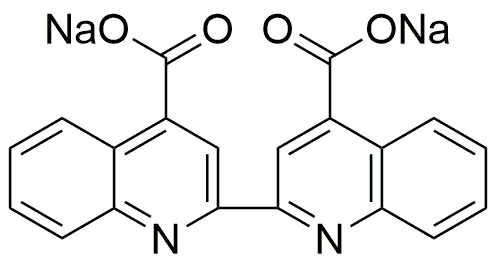Bicinchoninic acid disodium salt is widely utilized in research focused on:
- Protein Quantification: This compound is a key reagent in the BCA assay, a popular method for determining protein concentration in samples. Its high sensitivity allows researchers to detect low levels of proteins, making it invaluable in biochemistry and molecular biology labs.
- Antioxidant Studies: It is used to assess antioxidant activity in various substances. Researchers can evaluate the effectiveness of natural and synthetic antioxidants, which is crucial in food science and pharmacology.
- Drug Development: In pharmaceutical research, it aids in screening potential drug candidates by measuring their interactions with proteins. This helps streamline the drug discovery process and enhances the efficiency of developing new therapies.
- Biotechnology Applications: The compound is employed in various biotechnological processes, including enzyme assays and fermentation studies, where precise protein measurement is essential for optimizing yields and product quality.
- Clinical Diagnostics: It finds applications in clinical laboratories for the quantification of proteins in biological samples, aiding in disease diagnosis and monitoring, particularly in conditions where protein levels are critical indicators.
General Information
Properties
Safety and Regulations
Applications
Bicinchoninic acid disodium salt is widely utilized in research focused on:
- Protein Quantification: This compound is a key reagent in the BCA assay, a popular method for determining protein concentration in samples. Its high sensitivity allows researchers to detect low levels of proteins, making it invaluable in biochemistry and molecular biology labs.
- Antioxidant Studies: It is used to assess antioxidant activity in various substances. Researchers can evaluate the effectiveness of natural and synthetic antioxidants, which is crucial in food science and pharmacology.
- Drug Development: In pharmaceutical research, it aids in screening potential drug candidates by measuring their interactions with proteins. This helps streamline the drug discovery process and enhances the efficiency of developing new therapies.
- Biotechnology Applications: The compound is employed in various biotechnological processes, including enzyme assays and fermentation studies, where precise protein measurement is essential for optimizing yields and product quality.
- Clinical Diagnostics: It finds applications in clinical laboratories for the quantification of proteins in biological samples, aiding in disease diagnosis and monitoring, particularly in conditions where protein levels are critical indicators.
Documents
Safety Data Sheets (SDS)
The SDS provides comprehensive safety information on handling, storage, and disposal of the product.
Product Specification (PS)
The PS provides a comprehensive breakdown of the product’s properties, including chemical composition, physical state, purity, and storage requirements. It also details acceptable quality ranges and the product's intended applications.
Certificates of Analysis (COA)
Search for Certificates of Analysis (COA) by entering the products Lot Number. Lot and Batch Numbers can be found on a product’s label following the words ‘Lot’ or ‘Batch’.
*Catalog Number
*Lot Number
Certificates Of Origin (COO)
This COO confirms the country where the product was manufactured, and also details the materials and components used in it and whether it is derived from natural, synthetic, or other specific sources. This certificate may be required for customs, trade, and regulatory compliance.
*Catalog Number
*Lot Number
Safety Data Sheets (SDS)
The SDS provides comprehensive safety information on handling, storage, and disposal of the product.
DownloadProduct Specification (PS)
The PS provides a comprehensive breakdown of the product’s properties, including chemical composition, physical state, purity, and storage requirements. It also details acceptable quality ranges and the product's intended applications.
DownloadCertificates of Analysis (COA)
Search for Certificates of Analysis (COA) by entering the products Lot Number. Lot and Batch Numbers can be found on a product’s label following the words ‘Lot’ or ‘Batch’.
*Catalog Number
*Lot Number
Certificates Of Origin (COO)
This COO confirms the country where the product was manufactured, and also details the materials and components used in it and whether it is derived from natural, synthetic, or other specific sources. This certificate may be required for customs, trade, and regulatory compliance.


